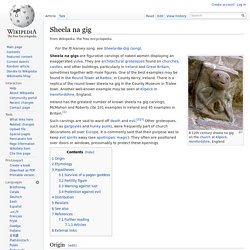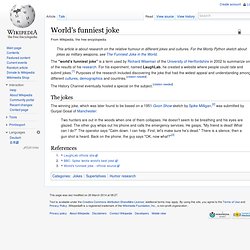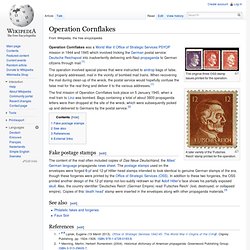

Taumatawhakatangihangakoauauotamateapokaiwhenuakitanatahu. Taumata.

Unusual articles. This page is for Wikipedians to list articles that seem unusual.

These articles are valuable contributions to the encyclopedia, but are a bit odd, whimsical, or something you would not expect to find in Encyclopædia Britannica. We should take special care to meet the highest standards of an encyclopedia with these articles lest they make Wikipedia appear idiosyncratic. Operation Snow White. Sheela na gig. Ireland has the greatest number of known sheela na gig carvings; McMahon and Roberts cite 101 examples in Ireland and 45 examples in Britain.[1] Such carvings are said to ward off death and evil.[2][3] Other grotesques, such as gargoyles and hunky punks, were frequently part of church decorations all over Europe.

It is commonly said that their purpose was to keep evil spirits away (see apotropaic magic). They often are positioned over doors or windows, presumably to protect these openings. Origin[edit] Lojong. Lojong (Tib.

Sea Org. The Sea Organization, or Sea Org, is a paramilitary[3] wing of the Church of Scientology, comprising the church's most dedicated members.[4] It has also been described as a private naval force,[5] and has operated several vessels in its past.

As of 2009, it consisted of approximately 6,000 members, according to official Scientology statistics.[2] The Sea Org was established on 12 August 1967 by L. Ron Hubbard, the founder of Dianetics and Scientology, initially on board four ships, the Diana, the Athena, the Apollo, and the Excalibur. It moved to land-based organizations in 1975, though maritime customs persist, with many members wearing naval-style uniforms and addressing both male and female officers as "sir.
Background[edit] Explanatory style. Explanatory style is a psychological attribute that indicates how people explain to themselves why they experience a particular event, either positive or negative.

Psychologists have identified three components in explanatory style: Personal. (Internal vs. External.) This involves how one explains where the cause of an event arises. People who generally tend to blame themselves for negative events, believe that such events will continue indefinitely, and let such events affect many aspects of their lives display what is called a pessimistic explanatory style[citation needed].
Some research has linked a pessimistic explanatory style to depression[1] and physical illness.[2] The concept of explanatory style encompasses a wide range of possible responses to both positive and negative occurrences, rather than a black-white difference between optimism and pessimism. Attributional style effects[edit] See also[edit] References[edit] Jump up ^ Seligman, M. Further reading[edit] World's funniest joke. The "world's funniest joke" is a term used by Richard Wiseman of the University of Hertfordshire in 2002 to summarize one of the results of his research.

For his experiment, named LaughLab, he created a website where people could rate and submit jokes.[1] Purposes of the research included discovering the joke that had the widest appeal and understanding among different cultures, demographics and countries. [citation needed] The History Channel eventually hosted a special on the subject. [citation needed] Poo bum dickie. 21, Bagram, or Twenty Plus One is a drinking game.

The game progresses by counting up from 1 to 21, with the player who calls "21" suffering a drinking penalty before the next round starts. The loser may add one new rule to the game, and starts the new round. Players are arranged in a circle, facing inwards. Operation Cornflakes. The original three OSS stamp issues printed for the operation.

A later variety of the 'Futsches Reich' stamp printed for the operation. Operation Cornflakes was a World War II Office of Strategic Services PSYOP mission in 1944 and 1945 which involved tricking the German postal service Deutsche Reichspost into inadvertently delivering anti-Nazi propaganda to German citizens through mail.[1] Gaman (term) American Dialect Society. The American Dialect Society, founded in 1889, is a learned society "dedicated to the study of the English language in North America, and of other languages, or dialects of other languages, influencing it or influenced by it.

"[1] The Society publishes the academic journal, American Speech. Since its foundation, dialectologists in English-speaking North America have affiliated themselves with the American Dialect Society, an association which in its first constitution defined its objective as "the investigation of the spoken English of the United States and Canada" (Constitution, 1890). Creepy Wiki Articles. List of legendary creatures (A) Beast of Gévaudan. The Beast of Gévaudan (French: La Bête du Gévaudan; IPA: [la bɛːt dy ʒevodɑ̃], Occitan: La Bèstia de Gavaudan) is the historical name associated with the man-eating wolf-like animals which terrorised the former province of Gévaudan (modern-day département of Lozère and part of Haute-Loire), in the Margeride Mountains in south-central France between 1764 and 1767.[2] The attacks, which covered an area stretching 90 by 80 kilometres (56 by 50 mi), were said to have been committed by beasts that had formidable teeth and immense tails according to contemporary eye-witnesses.
Witnesses also saw the beast was wounded at several occasions without dying. Those injuries include shots at point blank range. Victims were often killed by having their throats torn out. Horizon problem. Sokushinbutsu. Impeachment of Andrew Johnson. Theodore R. List of emotions. The contrasting and categorisation of emotions describes how emotions are thought to relate to each other. Nielsen ratings.